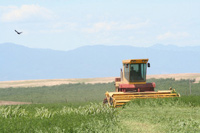



Corn prices have impact across many fronts
CALIFORNIA - Coffee shop talk in farming communities these days is about soaring corn prices, and whether that is good or bad depends on one's perspective. The dramatic increase in demand for corn has resulted in higher prices for alfalfa as well. The dramatic increase in demand for corn has resulted in higher prices for alfalfa as well. |
Economists say corn may reach $5 a bushel by fall, pushed by demand for corn for ethanol. As all boats rise with the tide, higher prices for corn pushes prices for other grains higher.
Farmers nationwide plan to plant more corn this year, according to government assessments of planting plans. In California they expect another 100,000 acres devoted to corn--a 119 per cent increase. If that comes to pass, this would be the largest acreage of planted corn in the state since records began being kept in 1926.
But while higher grain prices are an economic positive for growers, those costs provide a challenge to those in animal agriculture. Corn is a major part of feed for poultry producers.
"Feed accounts for 60 percent of the cost of raising chickens and turkeys," said Bill Mattos, president of the California Poultry Federation. "Producers will try to recover some of that cost from consumers, but the major portion of the increase will come from profit margins. The major players are all resigned to lower margins this year."
In addition to higher feed costs, poultry growers also face higher fuel costs for transportation. The major costs are for transporting the birds to market, but tractors for moving various materials in poultry ranches also need fuel to operate.
Mattos said fortunately farm prices for poultry remain strong in response to strong demand. Turkey remains a year-round favorite of consumers, who also demand various parts of chickens in fast food as well as for home use. But if corn prices reach $5 a bushel it will have a major economic impact on poultry producers, he said.
"In California alone, it will cost farmers an additional $150 million for feed for their birds," he said.
Dairy farmers are also struggling from the economic impact of high feed and fuel costs. In addition, the price they have been getting for milk has been below production costs. But milk prices have been creeping up since the first of the year.
"Right now April looks good for demand and we've had good upward movement in butter and cheese markets," said Michael Marsh, chief executive officer of Western United Dairymen. "On the price side we've finally getting past the cost of production for 2006. We have to hope 2007 costs will drop somewhat so we can be profitable. If we get to the end of the year and milk is at $17 (per hundredweight) but it costs $19 to produce you're still losing money."
Source: California Farm Bureau Federation











